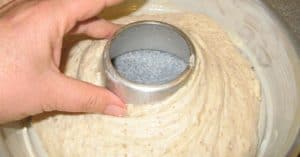If you’re looking for a super-easy way to make great bread, No-Knead Bread is the way to go. The only tricky part is remembering to start it far enough in advance of when you want to eat it as rises very slowly for a long time in lieu of kneading.
The one “problem” with no-knead bread, however, is that it requires a very hot oven and an oven-proof pan. What if you don’t have a conventional oven? What if you use an Omnia Stove Top Oven? (The previous link goes to my post about the Omnia; if you want to purchase one you can find the Omnia Stove Top Oven on Amazon.
The good news is that YES, you can bake No-Knead Bread in the Omnia. And while it will be great bread, it won’t have as crunchy a crust as when baked in a conventional oven. The bread itself still has a texture of artisan bread.
The same size batch works in the Omnia as I wrote for a conventional oven; below are the directions for baking it in the Omnia.

No-Knead Bread – Omnia Stove Top Oven
Ingredients
- 3 cups flour
- 1/4 teaspoon yeast
- 1-1/4 teaspoons salt
- 1-1/2 cups water
- 1/4 cup sesame seeds, cornmeal, oatmeal or wheat bran (optional)
Instructions
- In a large bowl combine flour, yeast, and salt.
- Add water, and stir until blended; dough will be shaggy and sticky – don’t be alarmed that it doesn’t look like “typical” bread dough. Cover bowl with a plastic bag.
- Let dough rest at least 12 hours, preferably about 18, at warm room temperature, about 70° F.
- Dough is ready when its surface is dotted with bubbles.

- Lightly flour a work surface and place dough on it; sprinkle it with a little more flour and fold it over on itself once or twice. Many recipes say to “Cover loosely with plastic wrap and let rest about 15 minutes” but I just let it sit, uncovered, while I rinse out the bowl.
- Using just enough flour to keep dough from sticking to your work surface (I use a nonstick jelly roll pan) or to your fingers, use your fingertips and sort of roll the dough around until it becomes a ball (maybe 30 seconds?).

- Put the dough back into the bowl, cover it with the plastic bag again, and let it rise about an hour.
- Grease the Omnia Stove Top Oven with butter, shortening or other solid fat (in a pinch, you can use vegetable oil, but sometimes the bread will stick). Sprinkle sesame seeds, corn meal or oatmeal heavily over the greased pan so that it forms a coating.
- With the bread dough still in the bowl, gently make a hole in the center by poking your finger and wiggling it around some (try not to totally flatten the dough):

- Then lift the dough out and place it in the Omnia, fitting the center hole over the center of the Omnia:

- Place cover on pan and let dough rise another hour.
- Place Omnia base plate on burner and preheat on high for three minutes (time it, don’t guess). Place covered pan with dough on the base plate and leave burner on high for 1 minute — again, time it.
- Turn burner down to just slightly over medium (on my stove, 4 out of 7) and bake for approximately 60 minutes. Top of bread will not develop the dark golden brown color that bread baked in a conventional oven does.
- The best way to test for doneness is with an instant-read thermometer. Stick it into the center of the loaf, away from the pan. When the bread is done, it will read at least 210° F. If you do not have an instant-read thermometer, the top of the bread should look totally dry and the edges be very slightly separated from the pan.
- Remove bread from pan to cool. While it’s tempting to cut into it immediately, wait at least 30 minutes and it will be much easier.
Notes
- If you are putting the whole loaf on the table, I usually do so with the bottom side up — as in the photo at the top of this article — as the bottom does get a pretty brown color.

Carolyn Shearlock has lived aboard full-time for 17 years, splitting her time between a Tayana 37 monohull and a Gemini 105 catamaran. She’s cruised over 14,000 miles, from Pacific Mexico and Central America to Florida and the Bahamas, gaining firsthand experience with the joys and challenges of life on the water.
Through The Boat Galley, Carolyn has helped thousands of people explore, prepare for, and enjoy life afloat. She shares her expertise as an instructor at Cruisers University, in leading boating publications, and through her bestselling book, The Boat Galley Cookbook. She is passionate about helping others embark on their liveaboard journey—making life on the water simpler, safer, and more enjoyable.
Simplify meal prep on board with proven strategies for provisioning, maximizing fridge space, and cooking delicious meals aboard your boat.














Kathy says
Going to try this for sure. Love the idea of the whole in the middle of the dough. I have been stretching dough into a ‘snake’. Your result is much prettier. Thanks Carolyn. PS Your book is my boat bible 🙂
Chris in Oregon says
thanks will be added to my menu.. Have you tried Native American (we use to just call it indian bread but now that brings up the India flat bread) fried bread? It is a camping staple for me mixed up in advance so all you have to do is add water. Fried in a pan with just a light coating of oil, we eat these for breakfast with cinnamon sugar and syrup then cook a half dozen more for lunch wrap bread and dinner time. I am cooking right now on my boat with a camp stove as I have yet to test the propane stove to see if or how it works. If you hear a big bang..
Ginni Gormley says
I was wondering if the No Knead Bread could be adapted to doing on the grill?
Carolyn Shearlock says
The Omnia works well on the grill, so I don’t see why you couldn’t!
Rachel L. Marcotte says
Thank you for sharing! When you roast vegetables in your Omnia, are you able to get good caramelization? When you roast cubed potatoes, do they get crispy on the outside?
The Boat Galley says
Here are the red potatoes I did in the Omnia. Trick is to do just a single layer so they are in contact with the pan — stir about halfway through the time. Nice and crispy!
The Boat Galley says
And here are the Brussels Sprouts. I’ve done lots of other veggies (and mixed veggies) with great results. Another trick is using high enough heat — my first couple of attempts at veggies weren’t too good as I was too afraid of burning the veggies. But you have to have heat to get the browning.
Rachel L. Marcotte says
Thank you for the photos and tricks! Super helpful.
Sherlene Eicher says
I love baking potatoes in the Omnia. They always turn out nice.
Nina says
Hurray! Thank you for this! I’ve baked no-knead successfully in standard ovens ashore, but never quite had it figured out with the Omnia (which I use much, for both baking and dinners, btw). Who knew high heat could be such a trick. You should let the Omnia folks know, so that if they ever do a reprint of their book, they’ll include this.
Thanks again!
Nina, Bika, fellow cruiser 🙂